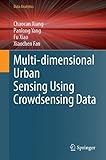Multi-dimensional Urban Sensing Using Crowdsensing Data [electronic resource] /
Material type: TextSeries: Data AnalyticsPublisher: Singapore : Springer Nature Singapore : Imprint: Springer, 2023Edition: 1st ed. 2023Description: XIV, 200 p. 1 illus. online resourceContent type:
TextSeries: Data AnalyticsPublisher: Singapore : Springer Nature Singapore : Imprint: Springer, 2023Edition: 1st ed. 2023Description: XIV, 200 p. 1 illus. online resourceContent type: - text
- computer
- online resource
- 9789811990069
- 004.167 23
- QA76.59
Chapter 1. Incentivizing Platform-users with Win-Win Effects -- Chapter 2. Task recommendation Based on Big Data Analysis -- Chapter 3. Data Transmission Empowered by Edge Computing -- Chapter 4 Environmental Protection Application---Urban Pollution Monitoring.-Chapter 5. Urban Traffic Application---Traffic Volume Prediction -- Chapter 6. Airborne Sensing Application---Reusing Delivery Drones -- Chapter 7. Open Issues and Conclusions.
In smart cities, the indispensable devices used in people’s daily lives, such as smartphones, smartwatches, vehicles, and smart buildings, are equipped with more and more sensors. For example, most smartphones now have cameras, GPS, acceleration and light sensors. Leveraging the massive sensing data produced by users’ common devices for large-scale, fine-grained sensing in smart cities is referred to as the urban crowdsensing. It can enable applications that are beneficial to a broad range of urban services, including traffic, wireless communication service (4G/5G), and environmental protection. In this book, we provide an overview of our recent research progress on urban crowdsensing. Unlike the extant literature, we focus on multi-dimensional urban sensing using crowdsensing data. Specifically, the book explores how to utilize crowdsensing to see smart cities in terms of three-dimensional fundamental issues, including how to incentivize users’ participation, how to recommend tasks, and how to transmit the massive sensing data. We propose a number of mechanisms and algorithms to address these important issues, which are key to utilizing the crowdsensing data for realizing urban applications. Moreover, we present how to exploit this available crowdsensing data to see smart cities through three-dimensional applications, including urban pollution monitoring, traffic volume prediction, and urban airborne sensing. More importantly, this book explores using buildings’ sensing data for urban traffic sensing, thus establishing connections between smart buildings and intelligent transportation. Given its scope, the book will be of particular interest to researchers, students, practicing professionals, and urban planners. Furthermore, it can serve as a primer, introducing beginners to mobile crowdsensing in smart cities and helping them understand how to collect and exploit crowdsensing data for various urban applications.


There are no comments on this title.